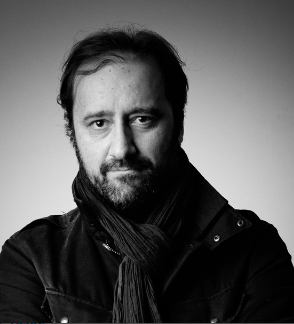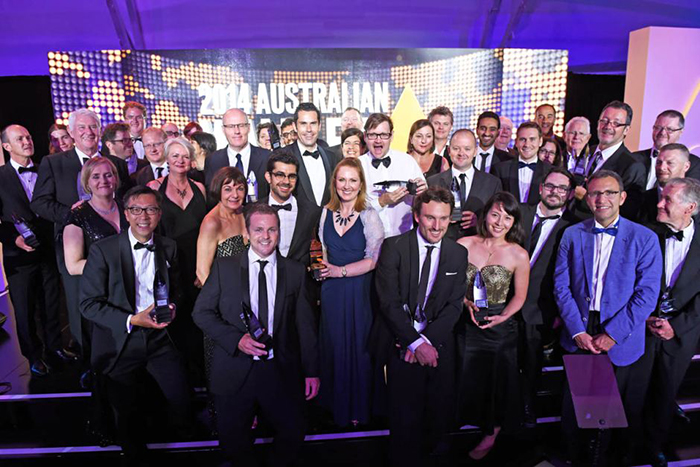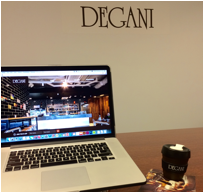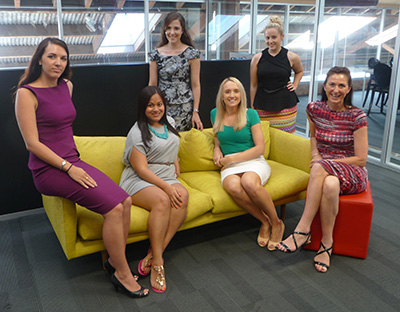By Mike Sullivan >>
TO BE AT the cutting edge of technology is difficult. To prove that you are at the cutting edge of digital technology to a potential client who, evidently, does not even understand you, what your company does, or how you can benefit their brand, is very difficult. Extremely difficult is doing it all from scratch, in a self-funded team, at a time when digital technology is hardly understood in your target sector.
Impossible? Well, that’s just a concept that’s unhelpful, if you are the co-founder and CEO of Holition, a creative agency that, well, is also a technology developer and, well, is trailblazing in digital marketing and brand building for many of the world’s renowned luxury brands. 
Jonathan Chippindale is that CEO and it was the reality he and his small team faced five years ago when they came together in the UK – all former luxury brand and retail marketing experts – and decided they could shake things up with creative use of technology that no-one had dared before.
Holition first bandied around its tagline – Augmented Retail – at a time when few marketing directors in the world knew what augmented and virtual reality technologies were, let alone trusted it enough to risk their precious marketing budgets. The Holition team found themselves working as creative educators more than creatives, as they tried to engage global luxury brands, some protecting hundreds of years of history, to join the creative space race.
“At an early meeting with a leader in the luxury field, I remember he said, ‘I love what you are doing but until someone can prove to me that the internet will still be here in three years, we are not going to go off and do anything mad and crazy with digital',” Mr Chippindale laughed. “I look back at that story and smile, because look how far they have all come.”
Holition’s show reels (on Vimeo, links below) prove the point. Mr Chippindale’s Holition teams have generated augmented reality in-store and on-screen ‘try-on’ applications for luxury watchmakers, fashion houses and jewellery brands like DeBeers, Asprey, Louis Vuitton, Tag Heuer and Tissot.
They used holographic and virtual reality projections to augment Dunhill fashion event in Shanghai.
There is not much they have not tried in creative use of digital technology to promote client interaction and memorable experiences with luxury brands – until the next pitch.
“Everybody wants a brand new buzz every time. We are never limited by ideas,” Mr Chippindale said. His goal is to bring about high-touch, and even joyous, interaction between brands and their potential customers.
“Our operating mentality is almost to be an anti-technology technology firm,” he said. “The technology in some way is almost like the reins holding you back, but it is the imagination that is the kind of whip driving us on.
“We find we have to look at things in a creative way, use the creativity to try to force the technology to behave in a certain way that is what we need … and if it doesn’t we either re-develop it or re-design it to make sure that it does.
“Otherwise it is always going to be a small idea. You are always going to be fighting the technology, the capacity or the screens – whatever it is. So it is always much better to look at a creative idea that is really, really engaging for brands and their consumers – and then, and only then, try to figure out what the right way to build it is.”
That’s quite an open brief, especially in the early days when, like all start-ups, Holition had to count the pennies while it coaxed potential clients closer to spending their precious budgets on what was a radical and unproven new area of marketing.
“Because of our background there were people who would give us that magic 10 minutes,” Mr Chippindale said, recalling how his team used their combined backgrounds and reputations in luxury brands and retail to leverage early crucial meetings and conversations.
“It was a funny old start, it really was. Most of the people were not interested in digital, full stop.
“They thought this was way too unimportant a channel to talk about important things like product and material and creativity and industry and service and what they did in store. Digital was commoditising, and e-commerce was bad, and therefore they shouldn’t get involved at all. That is the world in which we started.
“Because luxury didn’t dive in to start off with, and because we had sat on their side of the table in previous years, we knew what the sensitivities were and we knew how to phrase our conversations so that they would be happy. I think it was the right thing to do at the time.
“We started off with luxury because we came from luxury and knew it. But as an agency we kind of wanted to start with the people that were least likely to get it, because from that point they would really challenge us to get over the quality bar.”
And that is precisely what happened.
Brands like Louis Vuitton, Dunhill and Swatch were important clients, not just in a business sense, but for Mr Chippindale it proved “if they would take our projects we knew that we had achieved a certain level of quality”
“I thought we had to shoot very high and lift that creativity up to a higher quality and at that point we could decide whether we wanted to work at lower levels and go back for high street retail,” he said. “We had to show we understood their brand. We made it more difficult for ourselves by shooting high.
“Once we had persuaded the brands that we had a tool for them, things started to fall into place.”
LEARNING PARABOLA
Establishing businesses is always a learning curve, but Holition was on a rollercoaster ride that they were building themselves – powered by new technologies that they were usually creating – as they went.
“That’s why it has been such a really interesting journey for us,” Mr Chippindale said. “There are no rules. There is no Learning Innovative Technology Handbook 101. You can’t go to university and learn about how to do this.
“That’s why we love it. That’s why we have great conversations with some of the biggest brands in the world. Even though we are a relatively small upstart agency.
“Unlike where I started, in old-style luxury goods marketing, there were lots of people older, wiser and hairier than me telling me what I should and shouldn’t do – and the rules of advertising, and the rules of media buying, that had been learned and honed by generations. All the science.
“All the stuff that we do is so brand new that there is no-one in the industry that knows more.
“Not because I know more, but more because nobody knows anything yet and they are all holding hands – brands, agencies like us and consumers – trying to understand what kinds of technology really make a difference and how to use it.”
The early days of Holition were a wild ride that gives heart to other creative start-ups. Persistence was the fuel of this creative technology company, not the mountains of venture capital funding that some other tech-play companies were winning at the time.
“We’ve only survived from our own investment,” Mr Chippindale said. “We have never been to VCs or ever had a big chunk of money. We have always had money from within the organisation or organic cashflow.
“Most technology requirements were for our own R&D to develop.
“When we started out we put a fair bit of work in ourselves just to come up with our first product, which was an augmented reality application for watch and for jewellery. Then we talked to clients and not only did we have to sell them on the notion of digital but we had to sell them on the quality.
“There was a period of six to nine months where the two lines got closer and closer, where brands were becoming more interested … but not quite there. Suddenly we had this magic moment where Tag Hauer and Tissot watch companies both signed up within a couple of weeks of each other and we were away.”
Holition may have been populated by experienced and determined luxury and retail marketing specialists, but a tough early challenge was to find developers who understood where the company needed to go.
“We came from luxury products,” Mr Chippindale said. “I was a marketing director for Garrard and a marketing director for DeBeers. Some of the co-founders, they also came from retail or from luxury.
“We deliberately positioned Holition as an agency that is primarily focused on retail and with a strong focus on luxury. That was the world we knew.
“We knew also that, as people from marketing, we did not want to be dominated by the technology but we wanted to be the anti-technology technology people … not a digital wasteland tech firm.
“In those days when we were looking for people to work with us as developers, they were all quite young and were very techie and geeky, showing us 3D drawings of cave trolls or robots shooting missiles – not very luxury,” he laughed.
But succeed in finding the right team of developers they did and that foundation has underpinned Holition’s rapid success. Now that everyone on board understands the goals, the technology development team now serves up reality checks on the creatives’ desires to push the boundaries. It focuses on the reliability and ease of use of the experiences Holition generates.
“The first recommendation I’ll always make is to make sure you have a very square and straight chief technical officer,” Mr Chippindale said. “My guy Russell (Freeman) is always very quiet and confident and absolutely won’t take my commercial sort of sales push at all. He is always looking at things from the tech side.
“Commercially we are always saying, ‘Come on Russell, you can do it …’ and he just wipes that away and gives me an absolutely ‘no-nonsense’ approach. So if he says it can be done I have great confidence that it can.”
Holition works a little like a ‘skunk works’ but there is precision in the production system.
“We split each project into timelines, work milestones – and each milestone has mini milestones – and we track it as we go along,” Mr Chippindale said. “Most of our clients are fine with that.
“Every now and then we get a client where the lawyers are more in control than the commercial people and we start seeing things like penalty clauses for non-delivery in a contract – and it’s R&D. It doesn’t work that way.
“It’s like giving a chunk of money to cure cancer … it may take a bit longer because it has never been done before. So we have to have another conversation and even, sometimes, avoid that kind of project.”
Part of the business learning experience has been for Holition to understand the realities of where it can be successful and where it cannot. These limits tend to be on the business side, ironically, rather in creative and technical.
“Over the past five years we’ve been around – just by luck, fluke or fantastic management –we just happened to start Holition at a time when everybody was just starting to discover digital. So as agencies were learning how to use the kind of tools agencies like us provide, we have been learning how to build things for brands.”
From experience, Holition has found it is best to work directly with brands rather than in concert with agencies who currently represent those brands.
“We always try to go to brand. What we often find is that agencies don’t totally understand us,” Mr Chippindale said.
“One of my colleagues once said, quite correctly, that Holition is often getting other agencies work. We often find that we get involved in pitches for their clients, and when we’ve won that pitch we find we get moved out and all the money gets spent on normal media.
“Most clients love the work that we do and would love to do some of it, but as far as what the agencies want is more traditional media spend – so we somehow get lost.
“Like we have to educate clients, we find we also have to educate their agency and we never know whether the agency is putting across our budget to the clients or not. We do feel much, much happier taking to the client. I’d say 95 percent of our work is direct to client.
“We do struggle with identifying exactly what we are. I guess what we are is a creative services agency that specialises in creative tech. We are a creative agency but our output is technology rather than print advertising. But even that doesn’t describe it because creative agencies don’t have to do lots of R&D on holography and the like. But we are more like an agency than a tech play.”
CREATING WEALTH
The process of gaining a project is creative right from the start.
“What we try and do is come up with a proof of concept, quite quickly, just to get the notion across, try to sell that it, and if the client bites we use the money from that project to make it better,” Mr Chippindale said.
“Because we have so many different types of product, we don’t really position ourselves on product but creativity. Tech companies tend to make their money on a product’s next version. They make real money on versions seven and eight. But we are constantly doing versions one and two … so in some ways our creativity is our range and it’s a bit of an albatross around our necks. But here we are, five years later, so far so good.”
He admitted there was always a risk of creatively over-promising and technologically under-delivering.
“It is always a risk with everything we do. Pretty much every project that we have ever done has never been done before. There is a massive danger about that.
“I’m struggling to think of a project we have every done where there has ever been anything like it before. Pretty much a world first in whatever we’ve done.
“That said, we’ve never yet missed a deadline. So far so good.”
Apart from educating clients about the possibilities, Holition has found it must also help to guide clients in provisioning for marketing well in the digital age – and the issue is usually about provisioning funding.
“We had a good conversation with a client that we act as an innovation agency for,” Mr Chippindale said, describing the organisation as one of the world’s major cosmetics firms.
“One of the problems they face (in adopting new technologies) is that their marketers are applying so many measures like ROI calculators and spreadsheets and research that they de-risk every decision they make.
“If they are investing $10million, they know they will get $100million out of it. They have put in place a process that censures innovation. Always going for the ‘save money’. Nothing of what we do is about ‘save money’.
“What we are trying to do with this organisation is use their existing ROI calculators and their existing structure, but try to build into that some ability to take risk,” he said.
“At a very simple level it is about hiving off the money into some sort of floating budget which can be put towards some kind of project such as we do. So there is no-one having to justify, out of their current budget, but there is a kind of a war chest there that can be used against interesting projects that drive strategic wins.
“Some of these big brands are deliberately trained not to be able to appreciate liberal innovation.”
Mr Chippindale advocates to clients that they establish a line within their marketing budgets set aside for research and development.
“If you don’t do that and a great idea comes up, you have to go through a brand budgeting process and you might get access to the funds in a year or in a month, which mucks up the plan and by then the whole landscape may have changed anyway.
“If you go to a marketing director and ask them to key 10 percent of their budget to one side, they will put it to one side but what they really want to do is spend it on their traditional media channels. That 10 percent can buy them some more TV air or some more print ads, or you can do another trade show. The kind of stuff they are used to and therefore they know it drives growth.
“Not some mad crazy digital thing that Jonathan is putting forward. So even if they put that money aside, they are always fighting to get it back.
“There have been so many projects that have just withered on the vine, just because (we) couldn’t get global buy-in,” Mr Chippindale lamented.
SETTLED INTO DISRUPTION
By nature the creative work Holition does is disruptive – using technological tools to develop new engagement experiences with brands – but the company is using its reputation for innovation to generate a more secure future.
Even though Holition is clearly a leader in its field and has led for many years, unlike most technology companies there is no a warehouse of products to re-package.
“As I said, we’ve got the ones and twos and we haven’t got the sevens and eights and that is where you make the money,” Mr Chippindale said.
“We are at the point now where we have done so many different types of projects that when you metaphorically put them on a table you can see quite a lot of overlap.
“We did a project for L’Oreal and it required a completely new tracking algorithm. That tracking algorithm we are going to take now and completely re-purpose, but the basic underlying code will fit three or four other projects that we’ve got lined up.
“We are doing something at the moment that involves social media that we integrate into another of our projects and that is a very useful tool, part of the toolbox we can use in other projects. The learning from one project is definitely transferable.
“It’s not about trying to completely re-invent the wheel for each client. It’s about trying to re-skin it and re-purpose it. Try and re-use learnings and some of the code if at all possible.”
Holition is also ware of staying away from gimmickry in technology, aiming for more meaningful creation that builds luxury brand reputations. Brands do see that translate to increased sales and product value over time.
“There is a lot of augmented reality out there and a lot of it is stuff we don’t want to be involved with,” Mr Chippindale said. “We are all about quality rather than quantity.
“My take on it is, the very first project we ever did for Tag Heuer were AR watches, they were marketing ideas. Most watches are marketed in very similar ways … print advertising is very similar … they all have a brand ambassador … one might be a tennis player, one might be a yachtsman … one might be a ballet dancer, or whatever and they have got a very good PR team.
“But the little bit of the watch that generates that premium is buried away in the watch and a lot of people can’t see it. Augmented reality allowed the marketing team of Tag Heuer to show that they were more innovative and more inventive and you could see that little pod in the watch and understand more about it. All marketing.”
The impetus behind that kind of creativity is changing, because of cost.
“What we are seeing with AR now is that those marketing programs are dead in the water. Because technologists like ourselves have not been able to develop it cost efficiently enough that a client can have all that product augmented.”
When Holition introduced AR to the public as a way of ‘product sampling’ on the wearer’s body, it was a new and exciting technology that has proven difficult to scale economically.
“However, where we are now with our cosmetic applications, for example, people are more interested in using it and applying it to see how they’ll look.”
In the Tag Heuer initial program, he said, “All the watches we did that for were out of date in 12-18 months, so our whole application was out of date and couldn’t be used – and it’s quite expensive to keep renewing that very single year.
“We are still having that conversation with the merchandising team, which is becoming a lot more interesting … because I know the cost of what we can provide will be taken out of the margins and the brands can still make money. It will fit it better.
“Companies like ours need to do a better job with our technology.”
The other thing Holition knows is that it has to work closely with those people in client organisations who interact with the technologies.
“We’re not (helping to change client business systems) but the reason is that most client business systems are so huge and cumbersome. We are having to fit in around them rather than vice versa.
“However, some of the more human systems we are working with. For example, we are having to change some IT structures. The IT guys are the defensive line for protecting data and from viruses and what they say goes. We have had to develop systems around that.
“But I think what is more interesting is that if we do things in store then we must design them so that they are easy to use for the sales teams. It is an absolutely critical part of what we do.
“If they are not comfortable about using the technology themselves then the consumer hasn’t a hope in hell. We do a lot of work with the sales teams all the way through the development. It’s no good us building something and trying to force the teams to use it. So when we deploy we are very confident the technology will be used and used well.”
CREATIVE ADVENTURE
The creative journey is clearly what drives Jonathan Chippindale and his Holition crew. That is why he has come to Australia this September, to attend Creative3 in Brisbane, among other (what he likes to call) ‘conversations’.
“We are on a journey. There is no right or wrong to this,” he said. “There is no course to learn anything. The only way we can progress is to have conversations and talk about creativity and how this kind of technology can get used and developing ideas.
“Mankind crawled out of the primordial ooze and became what he is today by two people having a conversation and coming up with a third point that, individually between them, they would never have had.
We do a lot of work with universities. Very close to St Martins, very close to Cambridge University, very close to the London College of Fashion, UCL (University College London), Imperial … having conversations with like-minded souls that are not hampered by budgets or tech. Most of our best ideas have come from conversations. And mentoring and start-ups and talking to other people.
“When I heard about Creative Enterprise Australia I heard there would be lots of interesting people there with lots of interesting ideas. By exchanging these ideas we will all move forward.
“What I am hoping to do is meet a lot of like-minded souls in a very creative environment that are not hampered by notions of what their brands should or should not be doing.
“From my point of view, if I can help any of those start-ups I’m delighted to do that. I’d just like to have conversations with like-minded souls.”
Judging by his business history, Jonathan Chippindale’s creative conversations are likely to have soul, too.
www.creativeenterprise.com.au
www.holition.com
View examples of Holition’s work:
http://vimeo.com/54277771
http://vimeo.com/101634455
http://vimeo.com/102543190
http://vimeo.com/92836103
* Attendees at Creative3 at Brisbane Convention and Exhibition Centre over the next two days have the chance to learn from Jonathan Chippindale of Holition, along with dozens of other global creative industry leaders. It is one of the world’s most energetic and inspirational gatherings of business leaders at the creative cutting edge. Mr Chippindale will conduct a special presentation on Friday, September 19, in the Boulevard Room at BCEC from 1.30pm to 3pm. The session costs $99 or is included in the overall Creative3 pass.
ends


 How to resolve AdBlock issue?
How to resolve AdBlock issue? 


